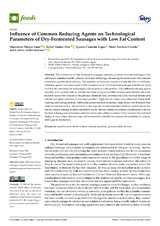Influence of Common Reducing Agents on Technological Parameters of Dry-Fermented Sausages with Low Fat Content
Autor
Vioque Amor, M.
Gómez Díaz, R.
Clemente López, Ignacio
Sánchez-Giraldo, Maite
Avilés-Ramírez, Carmen
Editor
MDPIFecha
2022Materia
Ascorbic acidStarter culture
Sodium ascorbate
Glucono-delta-lactone
METS:
Mostrar el registro METSPREMIS:
Mostrar el registro PREMISMetadatos
Mostrar el registro completo del ítemResumen
The production of dry-fermented sausages currently presents several challenges to be addressed: nutrition, health, sensory traits and technology are among the main issues that concern consumers and the meat industry. The objective of this study was to evaluate the effect of different reducing agents commonly used in the manufacture of dry-fermented sausages (salchichon type) with low fat content on the technological characteristics of the product. Four different reducing agents (ascorbic acid, a starter culture, sodium ascorbate and glucono-delta-lactone) were added to the meat batter to assess their impact on the physico-chemical traits, instrumental color, residual nitrates and nitrites and lipid oxidation of this meat product. High nitrate values were observed during both ripening and storage periods. All batches presented lipid oxidation values below the threshold that indicates meat rancidity. Adjustments of the original lean:fat proportion must be carried out on this low fat content sausage to obtain profitable results. Starter culture and sodium ascorbate have shown the best reducing and antioxidant activities among the additives studied. Once we have the technical design of the product, the next step will be oriented to identify the sensory characteristics in order to find a gap in the market.

